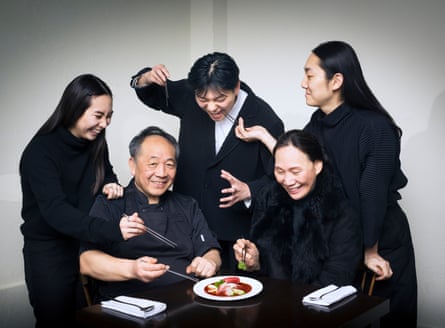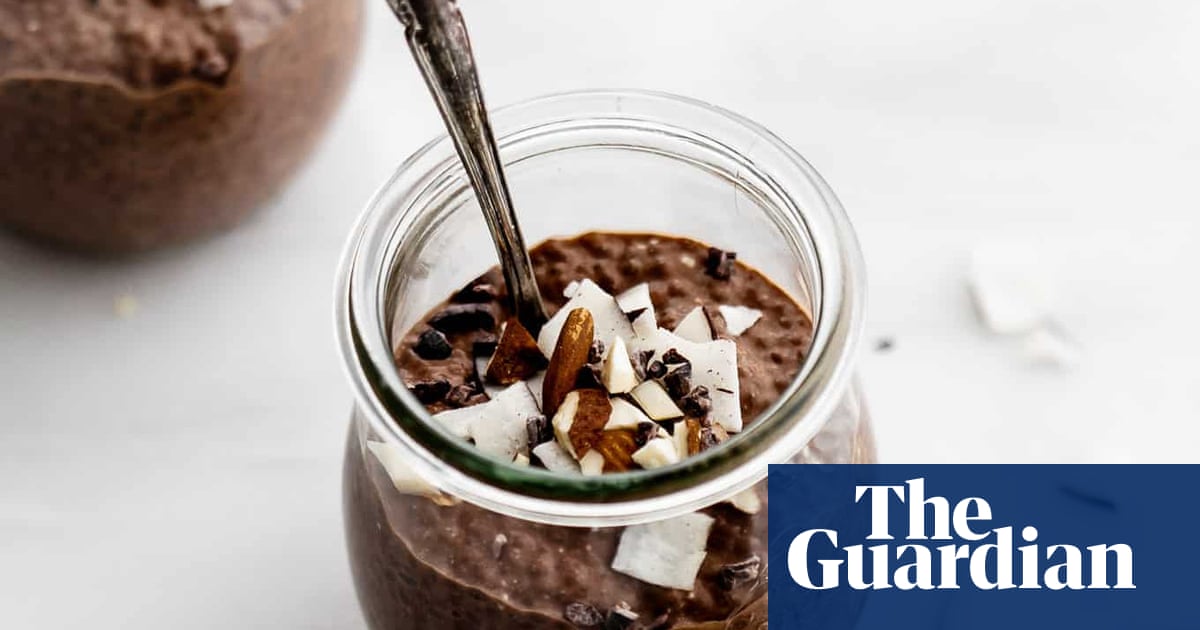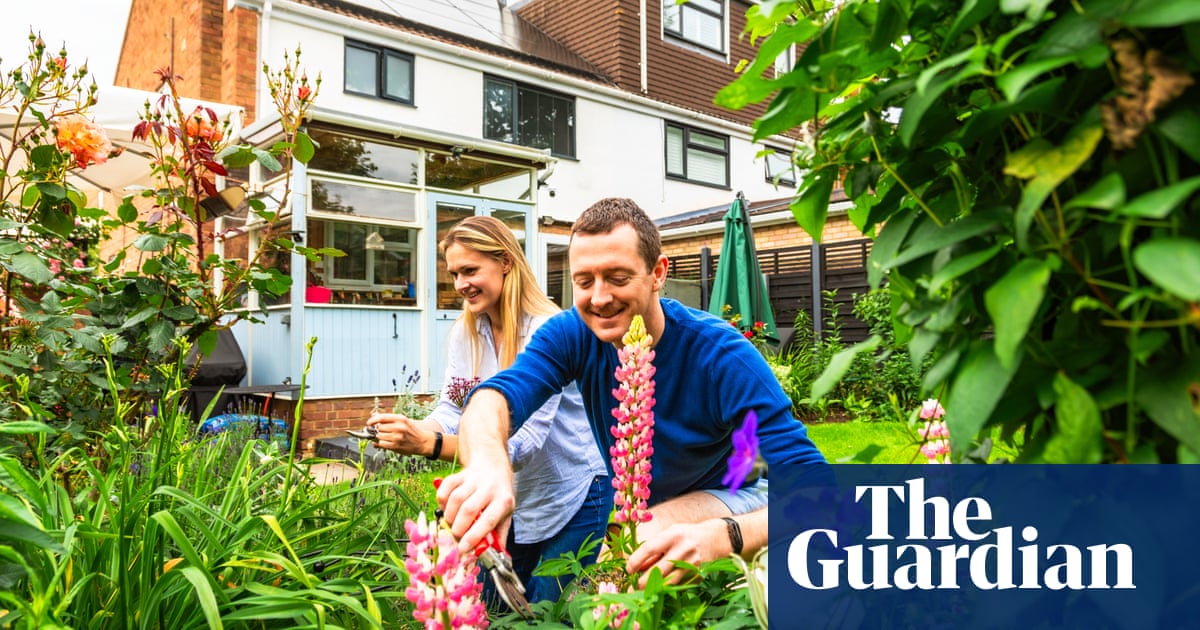People
Paris Rosina and the return of supper clubs
“My food is like your grandmother’s, but far sexier,” says chef Paris Rosina, the first part perhaps unsurprising given she grew up watching the likes of Fanny Cradock, Keith Floyd and the Two Fat Ladies. After three years as head chef at cult London bakery the Dusty Knuckle, Rosina changed tack in 2021, showcasing her retro, comforting yet humble style of cooking at a pop-up, Let Me Fill You Up. “It was six courses and all about stuffed food,” she says. Dishes included cabbage rolls, stuffed chicken wings and jelly (“I love jelly”), with a burlesque show thrown in for good measure. A regular supper club, Come To My House I’ll Make You Fat, soon followed, and dinners at her London home have sold out ever since. “I’m still working hard, but now I can do whatever I want,” Rosina says. “And I like doing whatever I want.”

Supper clubs are nothing new; chefs relishing independence and talented amateurs harnessing social media have been opening their homes to paying strangers since late 2008. “Coming from a non-professional kitchen background, I never imagined myself belonging in a restaurant,” says Ana Da Costa, whose Fat Tea supper club celebrating her Macanese heritage has led to restaurant pop-ups and events such as Meatopia. “Professional chefs often focus on the food itself, while amateur cooks like me bring a sense of warmth and familiarity.”
James Ramsden rode the early supper club wave in 2010 with Secret Larder. This “led unintentionally to the last 10 years”, which meant opening restaurants including Pidgin in London (now closed). Since he moved to Yorkshire, Ramsden’s supper club – now called The Clock Barn – is back, and he has joined the growing number of chefs swapping professional kitchens for something more homely. “I love to cook but have zero desire to work day to day in a restaurant kitchen,” he says. “Now, once a month I do lunch and dinner for 20 people, which is nice and buzzy but seldom overwhelming.”
Supper clubs scratch that professional and creative itch while offering greater autonomy over the food and working hours, and an element of certainty that a restaurant can’t. “There’s comfort in knowing how many people are coming to eat, that there’s one menu, and therefore how much money you’re going to take,” adds Ramdsen. But it’s not money that drives him: “If I crunch the numbers, it’s probably not worth doing, other than the fact I really enjoy it.”
He’s not alone: last year also saw chefs Marc Johnston and Jonathan Mackle join forces for the roving Tumshie supper club in Glasgow; Rosina’s February supper clubs sold out fast and she has more planned for spring. “I just love hosting – everyone sitting in the kitchen with the music on and the candles lit,” she says. “As my friend always says, your food never tastes better than at your home.” Anna Berrill
Meet the Miga family
Miga, arguably London’s standout opening in 2024, launched quietly in May, with an inconspicuous Instagram page (which currently has only three posts) to match its minimalist interiors. Its name means “flavourful house”, and its star dishes include ox bone broth; beef tartare with egg yolk and Korean pear; and braised short ribs, a delicately sweet stew with pears and carrots, alongside sticky rice and tangy, crunchy homemade kimchi.

Miga is a family affair. Hyun Sang Ko moved to London in 1990, working in many of the city’s top Korean and Japanese restaurants. He runs the kitchen, with his three children front of house; their mother, Kyung Suk Lee, has another, very different Miga in south London, which launched in 2020. The latter, son Jae Ko says, is “neighbourhood auntie cooking”, with classic dishes such as bibimbap and Korean fried chicken.
The Hackney restaurant has a more modern approach, and Jae’s pride in his father’s cooking is evident: “My dad is the best Korean chef in London, and arguably one of the best chefs in London. [Hackney] is where the competition is. I want to be among the best, because I know my dad can stand out.”
Inspired by the Korean cultural wave, or hallyu, spearheaded by its pop music and cinema, Korean restaurants are opening at unprecedented rates. In the US, Hyun Sang says, Korean food is “better than in Korea. Here, I don’t think so.” He is helping to change that. Tomé Morrissy-Swan
Rising star: Ash Valenzuela-Heeger

From the Test Kitchen, a World’s 50 Best regular in her native South Africa, to London’s three-Michelin-star the Ledbury, Ash Valenzuela-Heeger learned from the very best during her first 15 years in professional kitchens. “I endeavoured to push myself, moving around, becoming a better chef,” she says, and those formidable skills are paying dividends at Riverine Rabbit.
Opened last January in the Birmingham suburb of Stirchley, and named after a native of South Africa’s Karoo desert, the 12-seat counter-dining venue was an instant hit. Valenzuela-Heeger cooks solo while her wife, Erin, handles front-of-house duties. Praise for the restaurant’s warmth (“We want it to feel like you’re being hosted at ours,” says Erin) and its small plates – such as crab muffin, brown butter hollandaise, pickled lemon and sea herbs; or bone-in skate with a yuzu buttermilk beurre blanc – soon reverberated beyond the West Midlands.
There are themes to Valenzuela-Heeger’s food. She likes using seasonal game, and “cooking with fire is core”. Otherwise her dishes are a very now, very personal melding of hip, homely and high-end influences, embodied in eclectic snacks like wagyu biltong, boquerones and cheese on toast, or a fried chicken dish inspired by “throwing caviar on KFC tenders”.
That individual approach extends to the Rabbit’s opening hours. Erin is a materials scientist by day; to allow the couple to spend weekends together, Riverine only opens Monday to Friday. “All our hospitality friends told us we were mad,” says Valenzuela-Heeger. “Straight away, Mondays were booking up as fast as Fridays.”
Demand means Riverine could grow – extra staff, longer hours, more diners – but that is not on the agenda. For smaller independents, chasing every pound can be counterproductive: untenable at a personal leveland not always wise financially.
“You’ve got to be tactical about when you’re open,” says Valenzuela-Heeger, whose recent Michelin Young Chef of 2025 award will only make reservations harder to get. And you need to be memorable. “We take care of you,” she continues. “We are like an oasis in a really busy world.” Tony Naylor
When cakes meet chemistry – Dr Josh Smalley
If you are a Great British Bake Off fan, Josh Smalley may look familiar. A finalist in the TV competition in 2023, he hasn’t taken the customary post-show path. Instead, he runs an unusual cafe at the centre of the University of Leicester campus. Smalley – a postdoctoral researcher in chemistry – converted an old student hangout into a hub where he demonstrates his baking expertise and his knowledge of science.

He teaches the principles of chemistry through practical cooking displays and shows how scientific laws underpin the creation of cooked dishes. One of Smalley’s lectures examines focaccia, in which enzymes break down complex sugars in the dough and drive the fermentation that creates the pockets of gas which give the Italian bread its cratered appearance. During the demonstration, sensors in the bread monitor the production of carbon dioxide. “It is a great way to visualise what is going on,” he says. Other demonstrations include the chemistry of caramel sauce, the science behind swiss roll and how to generate gingerbread in a lab.
“There are all sorts of ways that science affects cooking,” says Smalley. “Take blueberry muffins: the sponge will come out red or pink if it is slightly acidic to begin with, but ends up more bluey-green if it is alkaline. People are absolutely fascinated by that sort of thing.”
Smalley has taken his shows to the Cheltenham Science Festival and the Royal Institution in London. An April performance at the Edinburgh Science Festival promises a demonstration of Easter food – including, presumably, the chemistry of the hot cross bun. Robin McKie
Maham Anjum, storytelling ceramicist
Maham Anjum is a ceramics designer who researches global craft traditions and revives them for the modern age. “I live and breathe it,” she says from her home in London, where she’s surrounded by shelves full of ceramics from around the world.
Inspired by the roadside potters near her grandmother’s house in Lahore, Anjum has worked closely with craftspeople in Sri Lanka, Ethiopia and India to create bespoke tableware for chefs including Jamie Oliver and Asma Khan, and ranges for companies such as Habitat and David Mellor.

“You need to be sensitive and respect the craft,” Anjum recalls of her work in Sri Lanka. “We enhanced their hand-making techniques and took time finding clays that could be thrown by the potter but were durable enough for the dishwasher.”
She travelled between Sri Lanka and London four times each year for 13 years. “I would sit with the potters, throw with them, introduce them to the buyers.” The potters were paid 30% more than the local market would provide for their work – which was bought by Vivek Singh’s Cinnamon Club, among others.
Storytelling is central to Anjum’s work with chefs, whether it’s creating a modernised version of the kulhar (chai cups) Asma Khan remembered from Kolkata, or her range for Vineet Bhatia that fused British and Indian pottery techniques to reflect his menu. Collaboration is also key. “Paula Wolfert, who wrote a book on clay-pot cooking, said: ‘The chef, the potter and the gourmand have been connected for thousands of years,’” Anjum says. “I do the same in a 21st-century context. It’s all teamwork.” Hayley Myers
David Carter, restaurateur of the moment
Last year was a good one for David Carter. The restaurateur with the Midas touch opened Oma and Agora in London’s Borough Market to great acclaim (picking up a recent Michelin award for best opening, and a star), after being smitten by the Greek islands on a trip in 2022. “I was so inspired I went back six or seven times that year,” he recalls.
The original concept was simply Oma (meaning “raw”), but the semi-industrial building was too big. “It would have been suicide to do just one restaurant,” says Carter. So downstairs became Agora, serving slow-grilled chicken thigh skewers and bowls of hummus and masabacha with hot crisps for scooping. “I was more confident about Agora; from a price perspective it’s accessible, but it’s also urban, filthy, and you can come in your pyjamas.”

Upstairs, Oma is more elegant, with raw sea bass and jalapeño aguachile, plus its much-lauded spanakopita gratin: “It’s more like the creamed spinach you’d get in a steakhouse but spiked with feta. It’s quite naughty.”
Carter was “born a glutton”. He grew up in Barbados, baking cakes with his mum before he could walk. Although architecture was the plan (“I love how design makes people feel”), he landed a job at the Four Seasons in LA, before joining the Gordon Ramsay Group in London. But cooking over fire is in his veins, and Carter opened Smokestak, with its brisket buns and pork belly ribs, in 2016: “We were late to the barbecue party, but the food represents me and how I grew up.”
Manteca, founded with chef Chris Leach, followed in 2019. Originally in Soho, now in Shoreditch, the restaurant quickly became a London must-visit, thanks to its smart take on Italian food. Silky pasta and nose-to-tail charcuterie showed Carter staying abreast of the curve – not that he believes in trends: “My guiding force is to create restaurants I want to eat in.”
What’s next? “I’m attracted to homely concepts: comforting, warming, never stiff.” Does that mean there is a new restaurant in the pipeline? “It takes a year to get a restaurant off the ground, and the year after you get itchy feet,” he says. “Put it this way: we’re approaching a year since Oma opened.” Anna Berrill
Jenny Lau has spent six years building a community through food, and her events have made connections well beyond her London home. She jokes it’s “for selfish reasons”: to create something she longed for. But for the hundreds, perhaps thousands, of people who have benefited, she is a hero who has built kinship among diasporic communities.
Born in London, Lau moved to Hong Kong with her family as a newborn, then back to the UK aged 11. “You never really think about your identity until you become framed as someone who doesn’t belong,” she says.

Lau studied classical music and is a writer and author – her first book, An A-Z of Chinese Food (Recipes Not Included) was published in January. In 2018 she visited the Hackney Chinese Community Centre in north London (now the ESEA Community Centre) and started hosting potluck meals, where each guest brings a dish and stays for the feast. Now she cooks at the centre’s twice-weekly lunch club, which is open to all, and facilitates supper clubs that raise funds for the centre and other charities.
Although the centre’s membership hails mostly from east and south-east Asian backgrounds, those who pass through its doors have roots across the world.
Lau has helped change the centre’s fortunes. Last year, it moved to a bigger site, and since Jenny’s involvement, younger people have started coming to the centre – an intergenerational connection that benefits everyone.
Emily Chung, a doctor, cookbook author and one half of the Rangoon Sisters supper club, takes her children there so “they can be around older Asian uncles and aunties. I was fortunate to grow up around that, but they don’t have that so much now. Jenny has allowed so many of us to connect with our roots.”
“Someone said my events are ‘for people like me, who feel they don’t belong, or feel safe and accepted in any space’,” Lau says. “That’s exactly what I’m trying to create, for the ‘unbelongers’ who feel a bit awkward and don’t fit in.” Melissa Thompson
Sam Grainger: the ideal modern chef
When Sam Grainger opened Manchester’s Medlock Canteen last year, he wanted its dishes – including a vast turkey schnitzel with salsa verde and a fried duck egg, and a deep-fried fruit pie and custard – to feel as generous as home cooking. “If you’re ordering a portion of mash,” says the 34-year-old, “it should sink you.”

Talented chefs rarely concern themselves with big portions, full bellies and offering clear value during a cost-of-living crisis. But Grainger, executive chef and co-owner at a growing portfolio of hip, friendly northern venues, has proven adept at reconciling his on-point modern cooking with that eagerness to please – and feed.
Grainger made his name with Belzan, a small-plates restaurant in his native Liverpool – which, at first, “was all about me”. When it opened in 2017, Grainger refused to serve potato dishes. It felt too easy.
Belzan remains cutting-edge. But Grainger has learned to edit his wilder creative urges and enthusiasm for new ingredients to create menus that take diners with him: “I’m bored of all that ego-cheffy stuff. The business has become more about people and enjoyment.”
This ethos has seen him hit a hot streak with venues including Madre, a Mexican restaurant collaboration with Breddos Tacos that has sites in Liverpool, Manchester and, soon, Leeds. This year, he will open Manchester bar Speed Limit and an east Asian-inspired restaurant at the city’s Treehouse Hotel.
Grainger first cooked professionally in Sydney and Thailand, where food (“so spicy, so flavourful”) offered daily revelations. He likes similarly big flavours and dishes that encourage communal sharing. “I don’t want to sit in stuffy restaurants having 70 minuscule courses,” he says. Dinner should make people smile: “It’s a social thing. It’s about big, hearty stuff on the table you’re going to pass around and chat about. It’s about people.” Tony Naylor
Kaneda Pen, cooking between cultures
Regulars to Soho may know that some of the most exciting recent restaurants began life at the Sun & 13 Cantons pub. At the moment, it’s Mamapen, where Kaneda Pen cooks Cambodian grills and curries, burgers with a Khmer accent and … tattie-mince noodles? It’s Pen’s favourite dish on the menu – comforting, warm, a big-hitter in savoury flavour. As with much of his food, it has its origins in the home kitchen. His Scottish girlfriend (a chef at neighbouring Mountain) was making mince and tatties. She grabbed some leftover gravy from the freezer, “but in that gravy was star anise, oyster sauce, soy sauce …” She put the gravy in the mince; they ate it with potatoes, but Pen kept thinking about noodles, turning it over in his mind, waiting for an opportunity to put it on the menu. When he did, it was an instant bestseller.

“We’ve achieved so much in such a short amount of time,” he says, looking around the dining room. In a different life, Pen used to drink in the Sun & 13 Cantons. Fifteen years ago, he was an executive in a media agency. He suffered burnout, got signed off for a few months and decided he had to reset, so he trained as a chef. He cut his teeth on the tempura section at Aqua Kyoto before cooking in a few places, most recently at live-fire outfit From the Ashes.
The first iteration of Mamapen happened in 2020 at a pub in Hackney. Now eight months into his new home, Pen has a young, diverse team he’s proud to lead and tables are full every night, often with people experiencing Cambodian food for the first time. Mamapen has been called London’s only Cambodian restaurant – Pen is unsure of that, but it’s certainly one of a scant handful in the UK.
“Sometimes we do get the authenticity police turning up,” Pen says, with a shrug, a sigh, a small smile. People who have been to Cambodia on holidays come in and ask for amok – but, he says, that fish curry is a royal dish. “My mum and my auntie never cooked that for us.”
The people who ask for amok need to sit down with Pen and learn about him, he says: “My story is as much being British as Cambodian.” He was born in Cambodia, but moved to the UK in 1980 to escape the war. Mama Pen had five kids in tow, and the ingredients she was used to were “non-existent” in Britain at the time. Cooking between two cultures, she did her best. “We grew up having soy sauce in bolognese, stuff like that.” She’s still Pen’s number-one inspiration: it’s her spring-roll filling that tops the pork toast. “We always get the best food at home,” Pen says, adding that though he’s proud to be one of the first, perhaps that’s why there hasn’t been such a need for Cambodian restaurants. “Our mums are the best.” Holly O’Neill
Food and drink
Sea Sisters: British conservas
“Sea Sisters isn’t tinned fish. It’s British conservas,” Charlotte Dawe says, speaking from the craft cannery she founded in west Dorset with her partner, ex-Trullo chef Angus Cowan. Conservas – high-quality preserved fish – had sustained and inspired the pair while they travelled in a van through Spain. “We became obsessed with trying the different cans,” Cowan says, “and thought it’d be cool to be the first producers in England.”

The first Covid lockdown was an opportunity to experiment in their small kitchen in east London. “There were lots of Post-it notes, and fish hanging everywhere,” says Cowan. Sea Sisters, named for their two young daughters, was launched the following year from a micro-cannery in Hackney Wick, before their relocation to the south-west: “To be closer to the fisheries and shorten the supply chain,” says Dawe.
Two years on, they are bastions of sustainability. “We have a massive responsibility to talk about local species and their seasonality,” she says. Cowan continues: “We only use ethically sourced fish, such as mussels, which clean the water and encourage biodiversity, and Cornish hake that have had the chance to reproduce.” Beyond offering a quality delicacy, their mission is to educate people about the British fishing industry. “Ninety per cent of British fish is exported,” says Dawe. “For us, success is someone enjoying a locally landed species for the first time and talking about it. It’s a small shake-up, but we’re hoping for a ripple effect.” Hayley Myers
Meera Sodha’s mushroom shawarma

It may not turn on a spit, or indeed contain meat, but Meera Sodha’s rejig of the Friday-night takeaway classic deserves a pass for its sheer moreishness. It’s simple: mix torn-up mushrooms and wedges of red onion with a paprika-spiked marinade. Bake, then serve with quick-pickled sumac cucumber, pitta, pickled chillies and – another swerve from tradition – vegan garlic mayo (the vegan part is optional). There are other versions of this dish, including one by Jamie Oliver, but Sodha’s is the shawarma I keep coming back to. Killian Fox
Urban wineries
“There is no shortage of good wine,” Warwick Smith concedes. But by making his in – get this – Walthamstow, the Renegade Urban Winery founder sees an opportunity to educate and innovate.

Typically marketed through a prism of vineyards, farming and terroir, Smith believes the detail of how wine is made is underappreciated. “My angle is to show why the making makes a difference,” he says, which includes inviting visitors to his winery and bar to explore its wine press, barrels and bottling-line apparatus.
Renegade sources grapes from Britain and Europe, and gets creative with them. It has made a pinot noir by combining British, Italian and German grapes. It adds craft beer hops to its Bethnal Bubbles sparkling white. British wine is a blank slate, says Smith, so “let’s be innovators”.
Across northern Europe, a small but growing band of urban wineries are working in various ways to produce distinctive wines in unexpected places: London’s Blackbook and London Cru; Chateau Amsterdam; Gothenburg’s Wine Mechanics.
Launched in 2022, Cumbria’s Northern Wine takes grapes from UK vineyards (saluting the logistics with a pinot noir called Roadworks on the M6) and creates limited-run wines so impressive they are served in Simon Rogan’s Michelin-starred restaurants.
Northern’s approach is patient, fastidious and low-intervention. “Time is a great friend,” says co-owner Stacey Raath. Long lees-ageing allows English wines to develop real “textural, layered” complexity: “We stay steadfast until it’s ready.” Tony Naylor
Renegade Urban Winery Northern Wine
God-tier fish and chips
Food is endlessly prey to fads and hype, and that makes a place like Drake’s in Knaresborough’s Silver Street all the more admirable. Restaurant manager Karen Rankine has worked at this fish and chip shop for almost 30 years, and its traditional methods endure. Fish is cooked to order in Yorkshire’s sacred beef dripping; batter is made each morning; mushy peas are steeped and cooked daily; tartare sauce is homemade. “It’s what we’ve always done,” says Rankine. The result is fish and chips of such vivid freshness and lip-smacking savoury depth that it really is a timeless classic. Tony Naylor
Mauby: defying stereotypes
A rich jerk chicken in a thick, spicy sauce, with perfectly crisp blackened skin. Charred pumpkin with Bajan tamarind sauce. Slices of tomato topped with sardines. An almost German-style sausage with mustard. Mauby in Brockley, south-east London, burst on to the scene in 2024 and was somehow both novel and familiar.

Daniel Maynard’s family is Jamaican and Bajan, and his partner Heleena McCrindle’s hail from Cornwall and Scotland. Mauby draws influences from both, but defies national categorisation: it is a London restaurant. “It’s food we love to cook and eat with friends and family,” says Maynard. “When you’re passionate about food and enjoy cooking, you don’t need to conform to one set cuisine. We’ve been called a Caribbean restaurant, but we’re not strictly that. We’re trying to defy stereotypes.”
The pair have run pop-ups in London since 2016, and transformed an old chippy into a warm, inviting room for their first restaurant. The menu is short, seasonal and affordable. “We try to offer a range, so that it can meet your budget,” says McCrindle. “It’s important for us that you enjoy every dish and feel welcomed in our space, whether that’s having the whole menu twice over, or a few cocktails and a couple of small plates in a nice setting.” Tomé Morrissy-Swan
Jonah Schulz: makes beer, draws beer
When brewer Jonah Schulz isn’t working his day job at The Kernel in south London, he’s designing logos and labels for another terrific microbrewery – Newbarns in Leith, Edinburgh, launched by a pair of Kernel alumni in 2019. “They offhandedly asked me if I’d be interested in helping with their visual identity,” says Connecticut-born Schulz, who studied fine-art printmaking in New York, “and I very much was.”

As well as Newbarns’ logo, combining a barn roof with an ear of barley, he has created more than 90 designs for the company, mainly can labels. “For the most part they let me get on with it, which feels like a special relationship because some of it has frankly been quite odd.” Schulz points to a pale ale called I Have No Proof, for which he created an elaborate film noir-style poster featuring a detective and a crocodile. More often, his labels prioritise typography and strong blocks of colour, but they’re distinctive and beautifully conceived, standing out amid the riot of designs in your local craft beer shop. Killian Fox
Gilda’s cinnamon morning buns
Jon Warren is working out how many cinnamon buns leave the ovens at Gilda, his bakery near Bishopsbourne in Kent, each week. It’s normally between 250 and 300. “We can just never make enough,” he says. “We’d love to make more.”

The pastries were created in partnership with a nearby hotel, The Pig at Bridge Place, who requested a local replacement for the breakfast bun they’d been trucking in from Dorset. A croissant dough made from Hinxden Farm Dairy milk, organic Shipton Mill flour and cultured butter from the Estate Dairy is layered with cinnamon, then plaited and cajoled into tall muffin moulds for height and a crisp casing. They’re rolled in cinnamon sugar after baking for added textural interest, but absolutely not drizzled with syrup, to keep them on the right side of sweet. “It’s the simplicity of it,” says Warren. “We’re keeping it quite natural and not messing around.”
How good are they? Good enough for one couple to request them as their wedding cake next summer. Kate Guest
Caro’s Cook Rite

Most of us think of all-purpose seasoning as the dried stuff found in supermarkets. But Caroline Bucchan is making a zingy fresh version from her kitchen in Forest Hill, south-east London. Born in St Vincent and the Grenadines, Bucchan came to London in the 1990s to work as a nanny, bringing her mother’s recipe with her. She set up Caro’s Cook Rite in 2023 and started selling her all-purpose green seasoning at local food markets. The range now includes an extra-hot version, blends for fish (with lemon zest), chicken (with rosemary) and lamb (with mint), plus limited editions for seasonal specialities. “My mother used her seasoning on absolutely everything,” Bucchan says, “and that’s what my customers do, too. They use it for meat rubs and on couscous, salads and stews.” Lindsey McWhinnie
Choc ice v ice-cream sandwich

There is a curious pleasure, no doubt rooted in nostalgia, to buying ice-cream not in a tub, a cone or on a stick but wrapped in greaseproof paper and sandwiched between two thin slabs of biscuit, usually containing chocolate. The London-based company Happy Endings, founded by Aussie chef Terri Mercieca, has been selling terrific ice-cream sandwiches for the best part of a decade; they are stocked at shops and restaurants all over the capital, and a few beyond. “They’re fun to make,” says Mercieca. “They involve about 15 more steps than just pouring ice-cream into a tub, but people respond really well to them.” Their bestseller, she says, is The Malty One, which is “like a Hobnob smashed up with a Malteser but more fancy”.
Similarly packaged, but more like choc ices than sandwiches, are the supremely delicious plant-based creations of Lucy Masters, who trades as Vagabond. Her inspiration came from four years spent in Los Angeles. “Anything was possible, like lavender caramel … and vegan ice-cream wasn’t really demarcated in the same way.” Returning to south London, she found local offerings “so boring” that she decided to make her own, first from home and now from a workspace in Brockley.
She makes plant-based ice-cream because her daughter can’t eat dairy, and she wants to make ice-cream available to everybody: “Not good for vegans, just good ice-cream.” Her peanut butter and pretzel is a highlight, though I particularly enjoyed one with cherries that took Masters a long time to perfect – she ended up boiling the cherries for hours, until they turned into a “rich and delicious” syrup.
“I love choc ices,” she says. “You pick it up, it’s a really nice object, you unwrap it, you see the chocolate but you don’t know what’s inside. And then you bite it, which is really fun. You get the crack of the chocolate. You can eat it on the go and it’s just slightly joyful.” Killian Fox
Modern Jew-ish food
A new wave of chefs are exploring their Jewish identities by experimenting with flavours and culinary influences, and highlighting the adaptive nature of diasporas themselves. Reinterpretations of secular Ashkenazi cuisine in particular have been building in the US, with chefs such as Jeremy Umansky (Larder Delicatessen & Bakery), Jeremy Salamon (Agi’s) and Katianna Hong (Yangban) leading the way.
In the UK, Ollie Gratter of Wilde’s Deli and Ruben Dawnay of Ruben’s Reubens aren’t just replicating the “New York-style” food. They’re drilling down into their Ashkenazi culinary and cultural heritage and marrying traditional flavours and cooking techniques with global cuisines, food trends and local influences, producing dishes such as barbacoa on challah, Polish/Chinese burnt leek dumplings and furikake smoked lox.
“It was a bit about heritage, a bit about my name, and exploring the foods that were all around me,” says Dawnay, who has homed in on pickling, curing and smoking techniques. He has also been led by flavours, beginning with the first reuben sandwich he ever ate, at Monty’s Deli. “The first time eating caraway seeds, I thought: ‘This is the coolest thing ever. I don’t know if I love them or hate them but they’re definitely present.’”
For Gratter, it’s about allowing space for reinterpretation: “Breaking traditions is an important part of progress. Traditional ways have their place, but adaptation is also inherent to Jewish food, like any other diaspora. I want to use recognisably Jewish ingredients in new ways.” Adrienne Katz Kennedy
Places
Little Piece of Bahia
During lockdown, Camila Vargas received a call from her mother in Brazil, who was receiving treatment for cancer and didn’t have long to live. Her mother told her it was time for Vargas to continue the family legacy of cooking food from their state – Bahia, in north-eastern Brazil.

“I didn’t know how to cook,” says Vargas, “but she said, ‘You’re my daughter, you’re black, it’s ancestral food. The food’s inside you, it will come out.’ And it did. I couldn’t believe the success.”
Bahian cuisine has its roots in Africa. Dishes are cooked in dendê, an unrefined palm oil. The ingredients aren’t hard to find, says Vargas – African shops stock many of them, including palm oil and black-eyed peas.
Vargas has sold her version of Bahian and wider Brazilian cuisine at markets in Manchester and London for three years, and now has a permanent site at Arndale Market in Manchester. Star dishes include acarajé, a black-eyed pea fritter filled with a creamy shrimp, coconut milk and nut paste and smoked prawns; and moqueca de camarão, a spicy seafood stew laden with rust-red palm oil. Homesick Bahians come from across Europe, says Vargas, while locals have fallen in love. “They are resistant to it, something they’ve never seen before. But when they try it, they go crazy.” Tomé Morrissy-Swan
Mara’s Picklery, Edinburgh
Thanks to Mara’s Picklery, burping ferments and briny provisions have arrived in Marchmont, Edinburgh, close to the leafy Meadows. With its custard-coloured frontage amid a sea of stone tenements, it appears playful, but the flavours served up are serious: think venison bresaola with persimmon carpaccio and chai-pickled grapes. At the helm are Eilish Leyland-Jones and Pragnesh Patel, who met at a vineyard in New Zealand in 2017.

Since opening in March 2024, they’ve been busy. “Our pickle plates have been flying,” says Leyland-Jones, “but we’re not just a shop selling jars of pickles, and we’re not just about pickle plates.” They are fiercely seasonal, she says. “We do quick pickles in the summer, but in the colder months we’re big on sweet and sour caraway cabbage, and we’re pickling romanesco as we’ve got extra.”
Mama Patel’s chai, based on a family recipe from Gujarat, is an instant warmer-upper. Their bestseller is a simple cheese toastie elevated by pickled chilli jam with apple, and a zingy ginger switchel is a good idea whatever Edinburgh’s weather. The pickles may change with the seasons, but the customers are already on repeat. Caroline Eden
Destination Thessaloniki
On the north-western corner of the Aegean, Thessaloniki was one of the most important cities of the Byzantine Empire, and centuries of occupation, trade and refuge have resulted in a heavy dose of Turkish, Arabic, Jewish and Baltic influence in everything from the architecture to a food scene unlike any other in Greece.
“Food combinations are more daring than in other parts of the country,” says Thessalonian chef Vasilis Chamam, who fuses the city’s historic traditions with global flavours and cooking techniques. (With a flurry of interest in contemporary Greek food in the UK, chefs like Chamam and Diamantis Kalogiannidis – ex Da Terra, now in residency at Pasero – are helming pop-ups in London, showcasing what makes Thessalonian cuisine so special.) Chamam has witnessed the city “going through a modernisation of its cuisine, with lots of chefs cooking food that’s looking at the city’s past”. To “taste the city’s traditions”, he recommends making a reservation at neighbourhood restaurant Iliopetra.
While you’ll see all the taverna classics in Thessaloniki, expect to see heartier food, much as you would in the north of Italy. Claypot cooking is a strength: meats simmered low and slow, the rich sauces finished with pasta such as hilopites or orzo. Spices are used in a way not seen elsewhere in the country: unusually, ginger is prevalent, especially in drinks, in hot salepi (made from orchid root) and lemonade from street carts; while tomato-based dishes might be laced with chilli, allspice and other aromatics.
Frappe was invented in Thessaloniki, but the presence of Greece’s largest university means that as well as old-school kafeneons, there are plenty of hip coffee shops and bars within the 4th-century walls. And those with a sweet tooth should note that Thessaloniki is known for its bakeries. There’s trigona, a filo triangle filled with a thick sweet cream, and it’s thought that bougatsa, Greece’s famous pie, originated in the city. Bougatsa Giannis is one of the most popular bakers in town, with a super social scene of people sitting outside, chatting over the classic sweet custard pies, as well as less common savoury versions filled with slow-cooked meat or cheese. It doesn’t open until 8pm and goes through till 3pm – which tells you everything you need to know about this exciting, 24-hour food-obsessed city. Georgina Hayden
Bizarre restaurant names
“It still astounds me that’s the name we went with,” says Alex Claridge of his Birmingham restaurant, Albatross Death Cult.
Opening a second restaurant was, says Claridge, “financially, emotionally, creatively, an albatross around my neck” – hence that Rime of the Ancient Mariner-inspired moniker. The name generated publicity, but was primarily intended to attract inquisitive diners – people with “a sense of humour” who would “embrace the slightly avant garde” and dig the restaurant’s highly creative seafood tasting menu.

For such a creative industry, few restaurants boast interesting names. The current trend is prosaic: Café This, or Something Canteen. Briefly, Claridge toyed with calling his counter-dining restaurant Counter.
Happily, like York’s Brancusi (Romanian sculptor), London’s Sesta (a medieval wine vessel), the playful Don’t Tell Dad or the taqueria Homies On Donkeys, its name a colourful homage to the owners’ Tijuana roots, Claridge took a more entertaining route. As did chef Simon Bonwick, currently cooking upstairs at the Oarsman pub in Marlow under the name Troublesome Lodger.
Goodbye Horses is both an epic slice of 1980s synth-pop by Q Lazzarus and a London wine bar. The title was chosen, says co-founder Alex Young, for its “nostalgic, somehow warm” aura: “The way those words feel is the feeling we’re trying to create in the restaurant.”
It is also “fun and mysterious” in not explaining what Goodbye Horses does. Intrigue is attractive, agrees chef Josh Overington. The name of his Yorkshire restaurant, Mýse (old English, to eat at a table), is opaque until you dine there and see how its dishes draw on historical English recipes.
Restaurants needn’t be “an open book”, says Overington. “I quite like not knowing what I’m getting into.” Tony Naylor
Albatross Death Cult Goodbye Horses
Chez Bruce: 30 years of stealth influence
“Chefs feel the need to perform, to do something different,” says Matt Christmas. That pressure, explains Chez Bruce’s head chef, is why chefs might use bananas in a tarte tatin: “Think of all the fruit you’ve dismissed to arrive at banana. What are you doing? If you don’t need to, don’t piss about with it.”
That guiding principle has, in the three decades since Chez Bruce opened, established the south London restaurant as a touchstone in British hospitality. Of course, it has evolved. Its food is less overtly French these days. It serves a miso-glazed aubergine starter. But OFM readers who, in 2006, voted it their favourite restaurant, could still eat a three-course dinner of soup, chauteaubriand and creme brulee from its Michelin-starred menu. Consistency, says Christmas, is “a big draw”.

Christmas, head chef since 2005, and co-owner and chef Bruce Poole insist on traditional cooking methods (stocks are made from scratch, breads baked in-house), and on big, bold flavours that interact with confidence. No daft garnishes. No fussy over-elaboration. “I hate meek cooking,” says Christmas.
Over the decades, numerous chefs have absorbed the Chez Bruce method. Joe Mercer-Nairne, chef and co-owner at London’s Medlar, loves their skilled process: “It’s hot pans. You cook. It’s old fashioned, quite labour intensive. But you get a better product.” Chef-restaurateur Gary Usher, founder of Elite Bistros, learned many crucial lessons in Bruce’s famous kitchen opposite Wandsworth Common. For example, highlight one primary flavour in soups and purees: “Parsley soup needs to taste of parsley. Season only to enhance that flavour.”
At times, Chez Bruce’s rigour and simplicity has looked anachronistic. But, in 2025, artisan skills and French brasserie cooking are en vogue again. Christmas laughs: “We’re almost back in fashion.” Tony Naylor
Le Doyenné, Saint-Vrain, outside Paris
There’s been a trend in recent years for talented French chefs to escape the big city and set up restaurants with rooms and a plot of land where they grow their own veg and raise livestock. One outstanding example is Le Doyenné in Saint-Vrain, an hour’s drive south of Paris. In 2017, Australian chefs James Henry and Shaun Kelly (who worked together at Au Passage) took over a “complete ruin” of a mansion and spent five years turning it into the restaurant-guesthouse of their dreams.

First, they revived the orchard and one-hectare vegetable garden, then they created a dining room in the stables formerly used by the artist Niki de Saint Phalle. They opened in June 2022 and have attracted a devoted following for their inventive, hyper-seasonal menu – a highlight from my visit was a spectacular board of crudités with charcuterie from their own pigs. The location sets the project apart: “We’re fortunate to have found these ideal conditions so close to Paris,” Henry says. “From the moment you enter, you feel like you’re transported. The city falls away, even though you’re really on the doorstep.” Killian Fox
Take a bite out of the ’burbs
“We have way more space than we could afford in town,” enthuses Jo Myers – who, with chef husband Stu, is poised to open the Swine Bistro in suburban Headingley, having previously run the Swine That Dines in Leeds city centre.
Historically, high-quality restaurants wanted, if not needed, to be in city centres, for the footfall and visibility. Myers’s migration is – like Jöro’s relocation from central Sheffield to Oughtibridge, or Pilgrim’s imminent relaunch in Liverpool suburb, Allerton – indicative of a new confidence that good food can thrive in the hinterlands.
Anecdotally, the pandemic repopularised “staying local” – relaxed socialising in neighbourhood clusters of bars, bakeries and restaurants, without the hassle of going into a city centre. The trend was already visible in foodie hubs such as Altrincham, Pontcanna in Cardiff and Bishopthorpe Road in York, and as demand grows in affluent or fashionable suburbs, restaurants are meeting it.
Sometimes that move is a personal choice. “We wanted to integrate into a community,” says chef Sandy Jarvis, co-founder of Bavette, in Horsforth, a northern suburb of Leeds. The Good Food Guide named it 2024’s best local restaurant, but its location has not stopped it attracting diners from the wider area. Indeed, Bavette is in such demand it retains two tables (only bookable directly, by regulars), to help maintain its neighbourhood feel.
Technology helps. Social media allows restaurants to advertise their presence anywhere; and, says Myers, thinking of her own city breaks, exploring Britain’s suburbs is easy now, “with Google Maps telling you which bus to take, or Uber”. Foodies will hunt out good food, wherever it is. Tony Naylor
Geo-Cafe, Caversham
Prospect Street, in Caversham, Reading, was a culinary wilderness when I was growing up nearby in the 1990s. Today, it is a pocket-sized but perfect go-to dining destination.
Clay’s Kitchen & Bar, raved about by Grace Dent, is famous for its outstanding Hyderabadi-style dum biryani and chepala pulusu (monkfish curry), but it is the Geo-Cafe a few doors down, run by Georgia-born Keti Maglakelidze and her family, that has my heart. Maglakelidze is certain that locals stay loyal to her “because of the strong and friendly sense of community” that the cafe fosters – and because “people appreciate that we are the actual makers of most things we offer”.
On the menu, the chicken and adjika (salty spice paste) wrap served with homemade tkemali plum sauce or walnutty, garlicky bazhe sauce sells best, Maglakelidze says, closely followed by the aubergine wrap, which is based on the classic Georgian mezze dish badrijani nigvzit, aubergine rolls stuffed with walnut paste. Caroline Eden
A book of cult sandwiches

The high-end sandwich boom shows no sign of abating, but, as food writer David Paw makes clear in the introduction to his new book Cult Sandwiches, for the recipes that pass the test of time we must look past the latest clout-chasing viral sensation. His compendium of 100 all-time classic sandwiches from across the globe is an attempt to do just that. It is a beautifully designed tome featuring everything from seafood po’ boys (New Orleans) to mie goreng toasties (Sydney) to balik ekmek (Turkey). Paw acknowledges that his list, though carefully compiled, barely scratches the surface – and that even the definition of “sandwich” is up for grabs (is a burger a sandwich? And if not, why not?). Nonetheless, it’s a loving and energetic culinary world tour, celebrating a cult that’s only gaining followers. Max Olesker
The Evin Prison Bakers’ Club
Iranian activist Sepideh Gholian was arrested during a peaceful workers’ rights protest in 2018, aged 24, and has spent most of the past six and a half years in jail. First, she wrote and – with the help of journalist Maziar Bahari – published a prison diary. Now, by the same route, she has created the extraordinary, genre-defying book, The Evin Prison Bakers’ Club – Surviving Iran’s Most Notorious Prisons in 16 Recipes (published in the UK in April), which combines stories of life inside Iran’s brutal carceral system with baking recipes.
The recipes – tres leches cake, finger-twist halva, date crumble – are integral to Gholian’s story. For her, and the women she befriended in custody, baking is a refuge from the horrors of prison and a way to remember those who died of neglect or were murdered by the authorities. The book is proof of Gholian’s triumphant resistance against a regime that wants her silenced, and a powerful message of hope for the future. Killian Fox
The Ómós Digest

Every week for the past four years, the gifted young Irish chef Cúán Greene has been writing thoughtfully and honestly about the highs and lows of cooking for a living. One recent dispatch of his newsletter, Ómós Digest – Ómós is also the name of his forthcoming restaurant, guesthouse and four-acre farm in County Laois – dealt with the impact of kitchen bullying; another considered the stigma of taking a career break, which Greene himself has been doing since leaving Dublin’s Bastible in 2020 (prior to that, he worked at Noma).
The newsletter, which has more than 4,000 subscribers, also charts his culinary travels, celebrates Irish producers and invites fellow food experts to contribute guest posts. It’s rare to find a chef who can write with Greene’s acuity, and he tells me the newsletter will live on after his new venture – with sky-high ambitions, backed by Stripe co-founder John Collison – finally opens in June 2026. Killian Fox

.png) 2 months ago
24
2 months ago
24













































